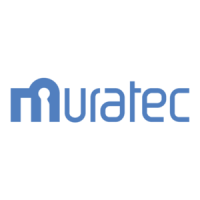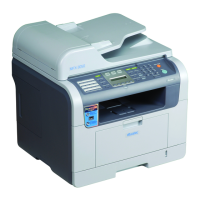
Do you have a question about the Muratec MFX-2550 and is the answer not in the manual?
| Functions | Print, Copy, Scan, Fax |
|---|---|
| Print Technology | Laser |
| Print Speed (Black) | 25 ppm |
| Print Resolution | 600 x 600 dpi |
| Display | LCD |
| Paper Capacity | 550 sheets |
| Automatic Duplexing | Yes |
| Scan Resolution | 600 x 600 dpi |
| Fax Transmission Speed | 33.6 Kbps |
| Copy Speed (Black) | 25 cpm |
| Copy Resolution | 600 x 600 dpi |
| Scan Type | Flatbed, ADF |
| Connectivity | USB, Ethernet |
| Interface | USB 2.0, Ethernet |
| Operating System Compatibility | Windows |
Describes symbols used for operational and safety information.
Explains control panel keys and touch panel keys.
Explains how the manual uses MFPs screens and that screens may differ.
Instructions on performing basic scans to various destinations.
Details on setting document type, contrast, and resolution for basic scans.
Steps to scan a document and send it as an e-mail attachment.
Save a scanned document to a shared folder on a network computer.
Store a scanned document in memory and make it available to registered users.
Save a scanned document to USB memory connected to the machine.
Save a scanned document to a specific folder on an FTP server.
Transmit a scanned document to another printer via a computer.
How to select document type, contrast, and resolution for scanning.
How to set the document type (Text, Auto, Photo) for scanning.
How to set the contrast level for scanning.
How to set the resolution for scanning.
How to set the scan document to color or monochrome.
Overview of advanced scanning features available in the product.
Details on various advanced scanning capabilities and their settings.
Transmit or save an image scanned using a specific scan size.
Transmit or save an image scanned with an enlargement or reduction ratio.
Transmit a single operation to multiple destinations simultaneously.
Scan separate documents as a single set of data.
Scan two-sided documents using this mode.
Adjust the image color to suit requirements during color scanning.
Edit the body and subject of an e-mail when transmitting a scanned image.
Edit the file name for scanned image data.
Save each scanned page as one file with "Batch Scan" function.
Attach a file on the network when transmitting or scanning a document.
Select the file format (TIFF, PDF, etc.) for sending.
Receive an e-mail regarding the location where the scanned document was saved.
Add a category name to scanned documents for filtering.
Set the storage period for documents saved in a box.
Enter comments for documents saved in a box.
Create image data and metadata for sending to a network computer.
Use application software that supports TWAIN devices as a scanner.
Delete documents stored in a TWAIN box.
Register or edit the name and I.D. code for a TWAIN box.
Import data stored in a TWAIN box using application software.
Set up the sender name, fax number, language, date/time, and communication line.
Basic procedures for transmitting and receiving faxes.
Steps for transmitting faxes, including manual and automatic methods.
Using manual reception or other fax machines for transmission.
Process of transmitting to a previous destination again.
Transmitting the same fax to many destinations in one operation.
Setting resolution and contrast according to the document and its text.
Setting the contrast to scan according to the document.
Inserting dialing options when entering fax numbers or registering address books.
Setting the transmission method (memory or real time).
Canceling fax transmissions and checking reserved transmissions.
Checking and canceling documents reserved for delayed transmission.
Checking or printing the transmission history for the past 100 jobs.
Choosing from five reception methods according to needs.
Automatic reception for fax only.
Prioritizing fax reception when using Fax/Tel mode.
Prioritizing call reception when using Tel/Fax ready.
Using both the answering machine and fax (Ans/Fax Ready).
Primarily using the phone when in Tel Ready mode.
Setting reception mode to manual or automatic reception.
Information on reception operations and indicators.
Stores received documents in memory without printing.
Recording methods available according to specified settings.
Procedures for making phone calls.
Steps to take when receiving a phone call.
Adjusting the speaker volume.
Transmitting faxes via fax or computer without printing.
Steps for transmitting documents created with Microsoft Office Word 2007.
Steps for transmitting documents created with Microsoft Office Word 2007 using advanced mode.
Overview of advanced fax functions available in the product.
Settings related to scanning, such as scan size and next document settings.
Transmit an image scanned using a specific scan size.
Scan separate documents and transmit them as a single document.
Various functions related to fax operations.
Select from three sender names registered in advance.
Attach a simple message or cover page to documents.
Specify the date and time to perform transmission.
Transmit to a fax server via a regular telephone line.
Request a document stored on another machine.
Perform communications using a sub-address or password.
Register F-Code boxes for sub-address or password communications.
Perform F-Code transmission using sub-addresses.
Retrieve documents stored in another machine's bulletin box.
Store documents in bulletin boxes set with an F-code.
Print security reception documents and bulletin box documents.
Delete documents stored in F-code boxes.
Functions related to security, such as restricting destinations and checking numbers.
Restrict fax destinations when closed transmission is set.
Check the destination machine's fax number before transmission.
Enter the destination twice for confirmation.
Store received documents in memory without printing.
Keep the PIN (personal identification number) private.
Functions related to useful reception, like auto distribution and separator pages.
Distribute received documents to a specified destination automatically.
Register individual distributing conditions to determine how to forward a received fax.
Change the first sheet of paper to identify each job.
Manage and check transmitted and received documents on screen.
Transmit and print received documents.
Select the document you want to print.
Delete a box document.
Functions related to useful internet fax operations.
Edit the body and subject of an e-mail when transmitting a scanned image.
Transmit scanned data as individual files.
Select the file format for saving the file.
Transmit mail text and attached file via fax.
Create a TIFF file for an Internet Fax.
Specifying destinations for fax, internet fax, and scan to e-mail functions.
Selecting destinations from the address book.
Searching for and selecting address books on LDAP servers.
Entering destinations using numeric keys or e-mail addresses.
Entering destinations by specifying registered search numbers.
Selecting a destination from the dial history.
Confirm or delete specified destinations before transmission.
Confirming or deleting destinations when the function is enabled.
Checking the transmission result of faxes and internet faxes.
Issuing the transmission report.
Reading the transmission history.
Managing the communication history of fax, internet fax, and scanner jobs.
Printing the history of the latest 100 jobs.
Setting reports to print automatically at set times.
Reading journal reports.
Registering destinations for easy use.
Registering or editing address book destinations.
Registering or editing groups of address book destinations.
Registering or editing folder shortcuts.
Registering or editing FTP server shortcuts.
Registering a color printer for Scan to Print Monitor.
Registering up to 10 destinations to display in the [Faves] tab.
Setting default values for scanner, e-mail, and fax functions.
Changing default values and other settings for the scanner function.
Changing default items and settings for scanner and internet fax functions.
Setting or changing default fax settings.
Registering other functions used with Internet Fax and scanner functions.
Registering ten default subjects and e-mail messages.
Registering up to 20 file names for scanned image data.
Registering up to 20 document categories for saving scanned documents.
Registering domain names.
Adjusting the color scan image settings.











